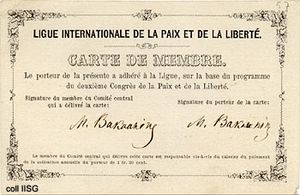League of Peace and Freedom facts for kids
The League of Peace and Freedom was a group formed to stop wars and promote peace. It started in 1867 when people were worried about a war between France and Prussia over a small country called Luxembourg. Even though that specific problem was solved peacefully, a bigger war, the Franco-Prussian War, happened in 1870. Because of this, the League changed its name and focus, becoming the 'French Society for Arbitration between Nations'.
This new group, the 'French Society for Arbitration between Nations', helped pave the way for important international organizations we have today. It was like an early version of the Permanent Court of Arbitration, which helps countries solve problems without fighting. It also influenced the League of Nations (formed after World War I) and later the United Nations, which works for peace worldwide.
Contents
History of the Peace Movement
The idea of groups working for peace started a long time ago. The first "Society of Peace" was created in 1830 by Jean-Jacques de Sellon in Switzerland. He believed that every person's life was important. This led him to fight against slavery and the death penalty. He then focused on promoting peace and helping countries settle their disagreements peacefully.
Later, the first big European Peace Congress happened in London in 1843. This meeting brought together people from different countries who wanted peace. More congresses followed in cities like Brussels (1848), Paris (1849), Frankfurt (1850), and London (1851). The famous writer Victor Hugo even led the Paris meeting.
In 1867, there was a lot of tension in Europe. Prussia had just won a war against Austria, and now France and Prussia seemed ready to fight. Frédéric Passy, a journalist, started a campaign to prevent this war. On May 30, 1867, he officially founded the International League of Peace and Freedom in Paris.
First Meeting in Geneva (1867)
The first big meeting of the League of Peace and Freedom was held in Geneva, Switzerland, in September 1867. Many important thinkers and activists supported this event. People like John Stuart Mill, Victor Hugo, Giuseppe Garibaldi, and Alexander Herzen were involved. About ten thousand people from all over Europe signed petitions to show their support for the meeting.
The League also invited the International Workingmen's Association (IWMA), a group of workers from different countries, to join. Even Karl Marx, a very influential thinker, was invited. He thought it was good for people to attend, but not officially as representatives of the IWMA. He believed that if workers from different countries united, it would naturally prevent wars.
The anarchist Mikhail Bakunin was also a key figure at the Geneva meeting. He joined the League's main committee. About 6,000 people attended the founding conference. When Bakunin stood up to speak, the crowd cheered, and Giuseppe Garibaldi, who was leading the meeting, stood up and hugged him. This showed how much respect they had for each other.
Bern Congress (1868)
The second meeting of the League of Peace and Freedom took place in Bern, Switzerland, in September 1868. The International Workingmen's Association (IWMA) decided not to send official representatives this time.
The Bern meeting had many lively discussions, especially about how economic and social fairness connects with peace and freedom. There were debates between those who focused on democracy and those who believed in socialism. The socialists, including Mikhail Bakunin, argued that true freedom and peace could only happen if everyone was equal economically and socially.
They proposed a resolution saying that economic and social equality was the most urgent issue. They believed that without this equality, justice, freedom, and peace couldn't truly exist. However, the majority at the congress rejected this idea. Because of this, the socialist group decided to leave the League for Peace and Freedom. They then formed their own group called the International Alliance of Socialist Democracy.
Lausanne Congress (1869)
The Bern meeting was almost the last one for the League. The main committee struggled to organize the next meeting. So, a committee in Geneva stepped in to arrange the third congress. This meeting took place in Lausanne, Switzerland, on July 11, 1869.
At this congress, a new central committee was chosen, led by Jules Barni. They planned to discuss how Europe could be organized like a federation (a group of states working together). They also talked about problems in Eastern Europe and Poland, and how these related to the League's goals of peace and freedom. The famous writer Victor Hugo was asked to be the honorary president, and he accepted. During this meeting, Ferdinand Buisson gave a speech where he said that children should learn that a uniform is like a costume, and any costume that makes you serve others without thinking is not good, whether it's for a priest, a soldier, or a judge.
What Happened Next
The League of Peace and Freedom stopped existing when the Franco-Prussian War broke out in 1870. However, it was soon re-established under a new name: the 'French Society of Friends of Peace'. This group later became the 'French Society for Arbitration between Nations'.
This new society was very important because it helped lead to the creation of the Permanent Court of Arbitration. This court was set up by the Hague Conventions of 1899 and 1907 and helps countries solve their disagreements peacefully through legal means. The society also published a magazine called United States of Europe, showing its vision for a peaceful and united continent.
See also
- List of anti-war organizations


